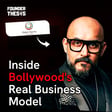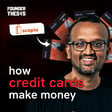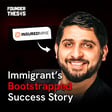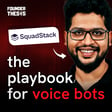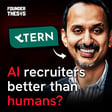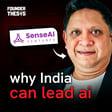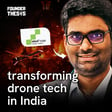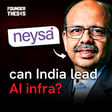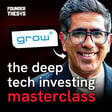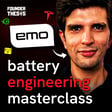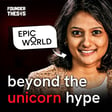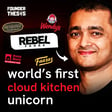Introduction to Prophmat and Anish Popli
00:00:00
Speaker
Hi, I am Anish Popli. I am the CEO and founder at Prophmat.
00:00:17
Speaker
If there's one takeaway from this conversation, then it's simply this. Boring is beautiful. Prokmart is in the boring business of managing non-core indirect procurements for manufacturers. And by taking care of this simple but time-intensive task for companies, Prokmart will cross 1000 crores in turnover this year.
00:00:35
Speaker
The credit for this massive achievement goes to Anish Popli, the founder of Pragmat, who loves all things
Focus on Execution for Founders
00:00:41
Speaker
boring. In fact, he shares that their profit margins are actually much higher on simple, boring products than on complex products. This episode is proof that as a founder, you must have the majority to not get distracted by shiny new ideas and sexy things. But just keep your head down and execute well. Stay tuned for this insightful conversation and subscribe to The Founder Thesis Podcast for more such counterintuitive insights from successful entrepreneurs.
00:01:07
Speaker
Anish, what is Prokmart? Tell me about that. So basically, we are a one vendor solution right for all the big oh manufacturing units. right So the third process that we work in is um it's a simple Pareto principle of 80-20 rule, where 80% of your procurement is what we call direct procurement in terms of value.
00:01:34
Speaker
which basically have the 20% of your supplier base, right? And then 20% of the value of procurement is the indirect procurement, which basically have 80% of the supplier base, right?
Challenges in Indirect Procurement
00:01:48
Speaker
So it is basically tedious for any large manufacturing organization to basically work on that, right? And secondly, it's a non core for any organization. Before anybody like us coming into picture, right? It was mostly done at very local level and in a very non-transparent way, right? So we all know that procurement, when we talk about procurement, right, the mall practices and corruption comes with it. So this was something that was very rampant in this category of product line, right? And what we are trying to do is bring a technology layer over it so that basically we can help
00:02:30
Speaker
the companies to streamline this procurement. So we understand the product line that isn't a degree for a large organization and basically make sure that we visit the factory, understand all the product and then create a catalog for them. So it's a curated catalog, right? So if Colgate is my customer, they will have a curated catalog for them, say 10,000 SKUs, right? so thing telling catalog just for cold gauge whatever they are procuring and once they come ah into that catalog lab so we also integrate with their yeah ERP system so once they come into that catalog they can directly order from there right so in a way you can say it's an Amazon for a manufacturing organization but ah yeah and we deal only mainly in the industrial supply space so it's very
00:03:27
Speaker
very important for any manufacturing organization as basically we are cutting a layer of intermediate trees and ordering processes.
Prophmat's Unique Approach to Procurement
00:03:36
Speaker
So it's a it's something that basically helps in their compliances also. So you do both direct and indirect for an organization or you focus more on? We focus only you on the indirect. So direct procurement is something that we feel is very core to an organization, right? so So what we call it direct, right? So if i if I'm talking about Colgate, right? So what goes into the paste, right? ah It might be some chemicals that might be going into it, right? That's very cool for an organization. And obviously they excel in that, right? We don't add value to that. okay We basically are aggregating the non-core part of it, right? Which is indirect, where actually it might be a small bearing in manufacturing
00:04:26
Speaker
oh or basically use of an abrasive or an oil lubricant or a safety or a PPE thing. That's what we're talking about. Okay, okay. This would also include manpower, say security guards. Typically companies work with a vendor.
00:04:50
Speaker
So our category, ah we don't do services as of now. So basically our category of product is called and MROs, right? It's maintenance, repair and operation. Okay. and and two It's a very boring business, frankly, right? so yeah Most people will not know about it, right? But if you are talking to a someone who is in manufacturing, you will be able to relate to it. otherwise ah Frankly, after engineering, i I also don't know that. right When I entered manufacturing, I was being aware of that. So, MRO is what keeps the plant running smoothly. Everything from spare parts to consumables, which you need to run the machines and all of that is MRO procurement book. So, you don't do, for example, office stationery.
00:05:47
Speaker
We do it, right? That's also a category. So obviously when you are taking all the indirect procurement for a manufacturing organization, it's a part of it. But obviously it's a very small part, right? So our office stationary and housekeeping will be around three, 4% of our business.
Anish Popli's Journey to Founding Prophmat
00:06:06
Speaker
Okay. Got it. Got it. So, you know, this B2B commerce intermediary yeah space has other well-funded competitors, like say Mowgliks is like a unicorn now in this space. so What is the difference between you and a Mowgliks? So actually in terms of what we do, it's almost a lot similar to what they are also doing, right? They are also in the MRO.
00:06:40
Speaker
They started with the same concept, and they diversified into a lot of things. We are still focused on this part of it. They currently do direct procurement also, um but we are very focused on what we are doing, and basically, oh we are building it horizontally. Geographically, we are increasing. so We have just started in Indonesia and Malaysia. Interesting.
00:07:10
Speaker
Tell me the you know how did you discover that this is a problem area? What's the journey of becoming an entrepreneur? So oh let's start with my childhood. In my childhood, if someone would ask me what you want to be, instead of an engineer and doctor, I would be saying a businessman. Entrepreneur, though, it's a very new world. right So I would say a businessman because So we, I come from a society in Belay, right? It's a very, it's a very small society. Belay Steel Plant was there. It was mainly the livelihood of most of the people there, right? So more there were two kinds of people, one who were working in the Belay Steel Plant. And then there was a businessman who were basically contracting or subcontracting or working for them, right? One thing I observed at that point of time that, uh,
00:08:09
Speaker
the people who are in the business, right? They have good money, right? So bat mi great thought process ta yeah yeah businessman manna it will it's more money, right? But slowly and gradually, when I did my engineering, the thought process actually moved away from me, right? It never came to me because I have to be an entrepreneur. Then after my engineering, I was working with BHEL.
00:08:39
Speaker
right? It's one of the public sector. I was working in Noida itself, right? I was into a core procurement of bought out items, right? So... What is bought out items? So for BHEL, so BHEL set up power plants, right? Yes. So BHEL has factories. ah They have factory in Haridwar, they have factory in Bhopal, they have factory in Richi. So So, they do a lot of stuff internally only that goes into a power plant, right? But then there are some product line which are not manufactured by BHL and they procure it, right? So, these are all bought out items for BHL, right? So, I was basically doing that bought out item procurement for the ah for BHL at that point of time for mainly their water system, right? So, it will be ah
00:09:35
Speaker
related exchanges pooling towers, right? Pooling towers will go like 400, 500 crore of values, right? So I will be doing that kind of procurement. It was a very techno-commercial kind of role. During my journey in BHEL, what happened in the into in the second year or third year, right? I was given a responsibility for one of their factory for the implementation of yeah ERP there.
00:10:04
Speaker
So when I was doing it, right So, it was basically moving from a total traditional procurement to an ERP system. So, when we were doing it, what we found out right and what was the pain point for us that for direct procurement of we had a good vendor database, we had good information about all the vendors, what we know, what is the information, what is the supplier, what is their quality and everything.
00:10:33
Speaker
But then there's a huge chunk of the vendors or suppliers for the indirect procurement. just ki about me We don't have any information, right? We don't capture any information. We don't capture any quality parameters. We don't capture on their delivery, on their ah anything, right? Compliances and everything. So traditional method, cha yaha but when we were putting it in an ERP system, actually it took us a lot of time to but love for the diet procurement or the, these suppliers, we were able to do it, say in a one month period. And then we were wasting our energy totally for the entire program. Right. Okay. So that's where I know that this is the pain point, right? ultimately The problem is a lot of SKUs and SKU is stop keeping, stop keeping unit, which is basically one right but all use lot of suppliers. Right.
00:11:33
Speaker
and low value like it's not it's not worth the kind of time you invest in it because even if you do a lot of effort and you save a few percentage points, it's not much of an impact on the bottom line. Yeah. Okay. So this happened in the second, third year of my BHL journey. Then basically I worked there for almost four and a half year and then did my MBA from I am left now, right? After
Early Development and Growth of Prophmat
00:12:04
Speaker
left themo on right that one Then basically, I started working for a startup, right, which was in EPC space. EPC is Erection Procurement Construction, right? So it's basically large turnkey projects. ah but But I would say it's a startup because ah know start-up in the time kiable EPC start-up, but it was at that stage, keyvo growth stage, with her it has done its 20 years, toha was point watch yeah third and it can track big projects. okay So I was there working as a business development head, they are actually working with the founder. So Java founder is our
00:12:57
Speaker
I started working right and that time of almost one and a half year with him was time pay. I realized this is what I also want to do. ah I also want to be a founder, right? It's an organized chaos. It's ah it gave me an holistic view of different because obviously I learned a lot in BHEL, but it was very structured hierarchy.
00:13:23
Speaker
<unk> right But here it was basically you get a holistic view working with the founder, you come to know about all the problems, ah all the problems and the success that you are dealing with day in day out. So that gave me something yeah up update and then obviously that experience that I had, ah so it was that experience that I had in the second or the third year of BHEL, I had that problem in mind. case go solve k yeah habitberro ala yeah I had to be an entrepreneur. Combine both, I started in 2015. What did you start with? like did you have a What did you need to start this business off? like Did you need capital initially or you just needed contacts to get your first few clients in?
00:14:19
Speaker
so e so It's a story, right? So what happened for me is I was just building something, right? Building technology. Basically like an e-commerce platform where people can choose, add to cart, checkout. But like was I was ah creating for a large enterprise. So it was not just a open e-commerce kind of thing. It was basically how a
00:14:50
Speaker
say structured procurement or a tender kind of thing will flow for a large organization. ah I built, I built, I asked someone to build it up, right? At that time, I was talking to a lot of people in different organizations, right?
00:15:07
Speaker
ah Startup, jadala obviously, oh startup, bit now ideaneath her so I started going in the events and everything, right? 2015 was the time. at mainly people B2C was something that was people were celebrating all this, right? And it was there. So B2B metavita, which now not neither there were people or around it or neither it was a actually what investor were looking for at that point of time. But ah it happened that i there was an Indian Mobile Association event in Indian Habitat Center.
00:15:46
Speaker
I just applied for it, got in the like top five startup to basically oh have a kind of display there. And this was after you had started with revenues or pre-revenue? This was pre-revenue. This was nothing. I was just asking someone to basically create a product for me. right And it happened that Mr. Dinesh Saravan, who is the CEO of India Mart, he was the speaker there. So after the event, right, so he might be leaving. So he said, let's look into the startups that are there. And he really liked it at that time. And he said that yeah next day, I know and want to meet you at my office. Right. And
00:16:41
Speaker
I went to his office and he said, yeah yeah, I want to write a small check. Right. As an angel investor, I said, yeah, with a company before me.
00:16:51
Speaker
no um nam dalinno oh ah raise ah was So that's how it started. Yeah. How much did you dilute at that stage? It was 7% dilution. Okay.
00:17:10
Speaker
Equivalent to say a YC kind of a dilution. Got it. Okay. Okay. Okay. yeah So then what? So I mean, it's not just the money, right? ah Having Dinesh Agarwal as an investor, like India Mart is the OG B2B startup, right? So having that kind of a backing would have helped you in multiple ways.
00:17:39
Speaker
Yeah, it certainly helped us because it was more of a strategic shift thing also, right? Where we got a lot of oh information on the supplier base also, which was really something that might took a long for us if they were not there.
Strategic Focus and Client Integration
00:17:56
Speaker
right ah Then also a lot of help on the tech side of it, how to build a product, right? And frankly, Dinesh Agarwal as a mentor for a B2B startup, right? It's something I really enjoyed working with him.
00:18:19
Speaker
how did the like like When did it become like a ah legit business making revenues? you like like I mean, probably you need to be like say handling 510 crores of procurement to call it a legit business. right So but why when did you reach that stage? So we started operationally in 2017. We took almost oh one and a half year or five quarters to basically develop the product and have the complete supply base verified for us. Right. Okay. i would just Just pause here very quickly. um you know There are two approaches to build. One is like you say, okay, I will do MVP, start with an Excel sheet, whatever, hack something together, and then
00:19:12
Speaker
get some proof of concept, some validation that, yes, people will pay for the service, and then invest in building a product, all of that. ah but But you decided to go the other way. Even before you had a single customer, single point of validation, you decided to invest in building out a product and onboarding and doing the KYC of suppliers and all of that. So what is the merit of between these two approaches, relative merits? well Actually, actually see it was something that we were we had a base of a base of clients right which we were in touch with and we were showing them the product again and again right but quota k in B2B you don't have that luxury of building a product afterwards right because it cannot be that you do it in excel and later on turn it can be done in the consumer business actually right
00:20:05
Speaker
But in B2B for me, for my software, right, to get integrated with their system, there are some protocols. Okay. There are some basic requirements that is required, right? And that requirement, obviously, when we are, when I'm talking about large MNCs, right, their approval actually comes from America, right? So you have to take that ah plunge, actually.
00:20:35
Speaker
And like you wanted the integration route because it ensures stickiness. If you were to just speak to a person and say, give me your list of products and I'll procure, that that would not be sticky. Stickiness would be lower. There would be a lot of churn. The product was the way to reduce churn, make them sticky.
00:20:57
Speaker
So actually, we have a because we have a client that is around 500 customers. And how do you define who is your client? like You need a minimum turnover. So for me, a client is someone who has a turnover of minimum 2,000 CR and has minimum 2 manufacturing facilities. like killier may solution at chani toro such diet or killier
00:21:30
Speaker
could that cha right tap tao direct indirect don know behanaf okay The time that he becomes big and he wants to concentrate on his product, on his core, on his core competency rather than basically working on the non-core and giving it to an efficient partner. The thought process actually is very important.
00:21:54
Speaker
Okay. Got it. Got it. And what is your pitch to them? Is it that I will reduce your costs? So my first pitch is I will bring you convenience. Okay. I will reduce the cost. Convenience in what way? Like you can You don't have to do manual purchase order release every time and purchase requisition. All of that is not needed. You have to post the postcar the a requirement and automatically through our software integration. ah The order is placed. Your order is placed. second Secondly, obviously for the 10,000 SKUs, right? Earlier when you were dealing with, say, 500 suppliers, right? So now you have to deal with a single enterprise, right? Which is a very professional way.
00:22:44
Speaker
Okay, so reconciling with suppliers, supplier payment, that vendor payment and accounts payable, all of those processes get simplified. the Your overhead goes down, take it, got it, okay. So it's a part of the soft savings for them actually. The number of purchase orders, the number of invoices, everything goes down for them. ha Right, right, right. We do give hard savings also, right, ah but that depends on client to client actually.
00:23:12
Speaker
Okay, so largely convenience, maybe also part of it would be like reliability that you will get it on time, you will get exactly what you ordered, no surprises. Yeah, so we have our SLAs on the delivery and the quality type. So basically, if you talk about the delivery and the quality in this kind of product, right oh if I talk about the adherence to the delivery and the quality,
00:23:38
Speaker
Before us, it would be something like a 60, 70% for a client. right We give them an assurance that we will bring the delivery address to around 95%. We will bring the quality more than 99%. So that's where we bring that streamlining these kind of procurement for them.
00:24:03
Speaker
Okay. okay okay okay guard it guard okay okay So we were talking about your launch journey. So you spent a year and a half in building the software, building the supplier database, ah making sure that it can integrate into the yeah ERPs.
Client Acquisition and Growth Strategy
00:24:21
Speaker
What is the integration that you ah do? like The moment they raise the requirement in the ERP that there is some API integration which tells you this is what has to be ordered.
00:24:32
Speaker
Yeah. So basically when they, so it's a like Amazon, like experience where you basically order a product, right? The purchase order actually goes into the system, our system, whichever the warehouse or which whichever the reason is. So we have currently 22 warehouses fan India. So that basically gets delivered to them directly. Right. So it's basically a lot of manual work that they will then find a purchase order, they will give it to the supplier, right? Supplier, he receive it or not, he will acknowledge it. So all that kind of thing didn't happen. And the degree demands are maintained because of that, because sometimes what happened in this product line, you give an order to supply or the supplier don't see any mail and all, you have to contact him again and again.
00:25:23
Speaker
Okay. Okay. Okay. Okay. Got it. Plus you don't have to give multiple purchase orders because you are providing 10,000 SKUs from a single vendor. So ah that also consolidates the purchase order. Got it. Okay. Okay. Yeah. So what next? You you built this product then? Yeah. So we got our first customer. Yeah. 2017. It was actually Colgate. Yeah. Okay.
00:25:55
Speaker
So yeah, first customer and then we basically worked out from there. Now we have like Unilever, PNG, PepsiCo, Cadbury, Britannia, most of the big big names in the FMC. So FMCG was the first sector that we basically catered to.
00:26:16
Speaker
But ah as far as the product line is concerned, we are sector agnostic. So we move to the other sectors also, we move to automobile. So in automobile, we have like Ghana, Herman for Asia. So what happened for us is actually in 2017, right? we We started looking for, again, funding, right? And fortunately, we didn't get at that point of time. heck ah Why do you say fortunately we didn't get? Because it helped us bootstrapped it. Our basic right ah have a very disciplined way of growing, right? It's actually a B2B business, right? It's a very, you have to be very disciplined, right? And it ah it's the way that
00:27:09
Speaker
oh Currently, I see that is the best way for us to grow at that point of time. So 2017 to 22, we were completely bootstrapped. Wow, five years. Yeah. Tell me something. What was the need for funding? And maybe a the way to answer this is to tell me your business model. What was it that you were charging your clients? what What were you earning? If you were doing, let's say, for a company like Colgate, I'm assuming you would be doing 100 crores worth of procurement. What would you earn that?
00:27:41
Speaker
So we were doing a part of the indirect procurement, right? So it would be some part of it, some percentage part of it. We had this share of business of around 30, 40%. And then obviously, what we were trying to do is we are moving up the value chain. So if they are buying from a retailer, you would be buying, slowly and gradually from the OEM, right? So it would be a journey from retailer to distributor to first level distributor to the OEM. So whatever the intermediates,
00:28:11
Speaker
intermediates are charging. ah Again, we were charging that. ah That was our commission, actually. Okay. so This is a pure margin model. There is no subscription, nothing like that. no purely fast It's a purely margin model. oh click If I buy a product at 100, I'm selling at 108 or 110, that's where I make my margins. Okay. For Colgate, how did the The procurement you were handling for them, how did that evolve? First year, how much of their procurement did you handle and what is it today? Just rough numbers. So after the share of business is concerned on the first year we were doing of the indirect procurement, we were doing around 10% of that. Currently, we would be around at 70%, 75%. Oh, wow.
00:29:03
Speaker
Why not 100%? Are there some categories which they prefer to do on their own or ah do they prefer to have multiple vendors don't want to be reliant on one or like what is the reason? No, actually there are some some category of product that we still don't deal in the indirect procurement space, right? There might be some services also that we might not be doing. That's why I'm saying that in that procurement there might be, so that's the reason that the share of business is cannot be 100% for, because you can't do each and everything, right? So we are dealing in around 32 categories as of now. Okay. What are they just some, like some of the main ones?
00:29:46
Speaker
mechanical, electrical, pneumatic, hydraulic, abrasive, safety, oil and lubricants, tertiary and secondary packaging.
00:29:59
Speaker
What is tertiary secondary packaging? Like when you're sending goods to your distributor, then that would be it. So, probated boxes that we see, right? Okay, okay, okay. The customer doesn't see that, but what the way you transfer it. So, primary packaging is something that is to the final product, that is near the final product, right? Right, right, right, right. For your tube would be a primary packaging. Okay.
00:30:22
Speaker
Again, the packaging would be that for a paste, if you are seeing that outer cover, right? That would be secondary packaging. And certainly would be 100 of that pack kept under a corrugated box. Got it. Okay. Okay. And what is the number that, like how many crores of procurement are you handling for Colgate? Just as an example.
00:30:50
Speaker
So we are handling around 10 to 12 CR for them. Okay. Okay. Which for a size company, the size of Colgate sounds small, right? Like if you're saying 2000 crore plus businesses,
00:31:05
Speaker
ah so their indirect procurement is only like 15 CR types for a 2000 crore business. Yeah, it's around 2015 CR for them, 15 to 18 CR.
00:31:16
Speaker
um So, it basically exclude a lot of services. and Services is a big part of it. Okay. okay guarded Got it. Got it. Okay. And what is the total procurement that you do every month? Like how many crores worth of? So, currently last year we did around 625 CR. Wow. Okay. For you the top line is the entire amount that you procure for a business. Like that is the yeah top line. Yeah. but Because you buy it on your books and then you sell it further and you charge a margin on that. Okay. Okay. And what is a margin profile? Like on an average, like what is the blended margin that you get? So on the gross margin side, we make across around 12%. Okay. And we have some logistic charge that is the CM at the CM level. We will be making around 10%. Okay.
00:32:11
Speaker
And then we would have our SG&A cost. Yeah. Okay. SG&A sales general administration. Yeah. So employee costs plus all the rented warehouses and offices. So frankly, yeah, 5% of a bit tells what we are at. Wow. That's so you are a bit a positive as on date.
00:32:34
Speaker
Yeah, yeah so as I said, in 2017, we didn't have any choice. ah So that made it possible for either the competitor landscape or anything. Some business starting, some property business. career Once we started, obviously. Amazing. ah How did you keep it a bit positive? Some advice on that?
00:33:01
Speaker
like What are the things doing really? It's a lot of discipline. i Disciplined around what? Disciplined around the cost that you are giving, doing. You need to negotiate hard with the suppliers. That's not, I would say, the mantra. I would say he You have to balance between how ah you are growing at a particular stage because what happens is sometimes it's a business. right It cannot be something like Amazon or ah Zomato. Let's put the convenience key and tomorrow say my prices are higher.
00:33:51
Speaker
like That cannot be there in this B2B space, right? So, the one thing that you have to make sure is basically your Apki service, a what you are giving to them, right? The customer is actually valuing it. right and also i up charles law If it makes sense to that customer, he will be ah charging, giving to you. And frankly, this model is 20, 25 years old, if I see in Europe and North America.
00:34:21
Speaker
So, the SSHC runs the manufacturing, right? i say It becomes mature, right? You want to focus on your poor competency.
Sales Strategy and Pricing Model
00:34:36
Speaker
So, that's why the people are ready to pay for that convenience, right? They are ready to pay at least an equivalent of what they were paying earlier. as any eggi helpba they would come in and say i no person comes up no past percent percent from right So you should be very clear from the day one that who will be your client. right You can't make everybody your client. But as I said, k hamal universe to bahar from five hundred client are universal just may yeah a client that are dissatisfied oh yeah though that's a problem for us.
00:35:19
Speaker
right? And that's our strength. Oh, basically, the one strength that basically bootstrap gave us gave us at that point of time, you have your attention ever 100%. Right? ah Amazing. Okay. Well, there will be cookie is my customer acquisition cost of the coffee jar because it takes time for a B2B client to get converted ti around six to nine months. Okay.
00:35:45
Speaker
When you are spending so much time to get a client converted, right, appka for elma and nitche and nikco ja then it becomes a problem. And that's what happened when a lot of funding comes. you per client toarra nietzs and nikle bijara but a but we call coffee higherty
00:36:09
Speaker
So what happens in the six to nine months? Tell me about your sales journey, like a journey of acquiring a client. How does it happen? So see, our sales is a very top-down approach, right? So we will be talking to a CEO or a chief procurement officer or a CFO, right? Okay. These three people are the key people.
00:36:33
Speaker
there's a fourth category of people that is a digital transformation person, right? There will be a CTO who will be transformation officer, right? Got it. So we start with them, right? First of all, to read reach out to them is the first key thing, right? Getting that people. Then basically on day zero, we basically visit them, make them understand what we do, right? What's the concept is about.
00:37:02
Speaker
and how we basically execute it, right? It takes out two, three meetings and there are a lot of stakeholders. to i mean but government officers start up or He will make us make sure that he will ah let the manufacturing people meet us. He will make sure that the CFO meet us, right? So even purchase set of meetings left here. Then basically what we do is sign an NDA agreement, non disclosure agreement with the client.
00:37:29
Speaker
get their data, visit their factories. The one major problem here is the data is also not that great. Factories are data. And as I said, this was a tailspin or a class he spent for an organization. night buthabuah raha So we visit them, understand the product, then create a catalog out of it. right Then obviously some negotiation on the prizes.
00:37:59
Speaker
like you When you create the catalog, essentially, you create a login for them where they can log in and see all the products that they have bought in the past which are all listed there with the pricing that you feel that this is the right pricing and then they tell you, no you are yeah on your website, this price is too much and we can get it at a cheaper price. That's how the negotiation happens. So basically, it's on the last procurement price,
00:38:24
Speaker
Right. So basically they give us the last procurement price, right. And they will say that either you match it or give some discounts on that. Right. Obviously they say that if I'm buying at a hundred, I will not give you a hundred one. Right. So that basically we do, but we host a catalog after that also. So this is something that is happening at the H O. Right.
00:38:49
Speaker
a german major big by agreement or jaga Then this catalog goes live and then they will ask their factory boss, this is the catalog. You have to order this material from here only. Okay. You can't go and basically you can't go locally and buy it from someone else. Okay. Okay. Okay. And when people are adding products to the cart, they can see the estimated delivery date and things like that. Yeah. What you see on Amazon. Okay. Yeah. Okay.
00:39:17
Speaker
okay They can track it, they can do everything. It's a totally commerce experience. So in that obviously, the whole idea was to make B2C experience in this B2B.
00:39:30
Speaker
okay okay ah is there a Like, you know, the the price sounds like a point of friction. ah I mean, okay, so you signed up and you agreed on a price. Oh, prices increase, right? Because of whatever global commodity price fluctuation, maybe the cost of lubricant has gone up. How does that happen? Are you allowed to increase the price on your own or do you have to go back and re renegotiate and all? Like, how does that happen? How is that friction removed from pricing?
00:40:00
Speaker
So in most of the, and what happened is there's a six month period where they ah revisit the price, right? And as you said, most of the prices are basically indexed with some of the indexes out there. Give me an example. So something like a chemical, right? It would have a index on the chemical side of it on the RBI side, right?
00:40:27
Speaker
okay or say a plastic would have a something on the plastic prices that basically the major player like Reliance is giving out there, right. So, Ectovola partner, secondly obviously there are list prices also. So, if say cable manufacturer increases his price, he will increase the list price also. okay um good So, the discount percentage remains the same.
00:40:54
Speaker
but the less price changes. Okay. okay So, so pro data increase based on what the source price has increased with. Okay. like So once the prices are finalized, you have a lot of systematic and method, methodical, right? It's with ah friction. ni Obviously, usuallyly the first time that you get into a contract, obviously you are negotiated as much. Can you give me some examples of like counterintuitive insights. For example, maybe people assume that this is a high margin product, but actually you discovered that there is more margin in a different category. you know Based on your experience of the last six, seven years, what are some of those counterintuitive with insights about the indirect procurement space?
00:41:46
Speaker
so see my love The thought process. may i thought process to eight tell your mero I learned over a time. It's a boring product. or touch imagine yeah okay okay okay What is the most boring product you have? It would be a BOPP tape, right? A simple tape. No one will care about it, right? Right.
00:42:14
Speaker
right We have electrical and technical technology and you will basically start comparing it once a brand of the season. It becomes complicated. okay The more product is like a commodity, the higher is the margin. That's very counterintuitive. People would have thought that the margin would have been a commodity.
00:42:38
Speaker
so I think proprietary products are more involved in that decision making. Oh my god, I know. Oh my god, I actually use them. You're right. I may not maybe search for them, right? I'll search for them. Who wants to
Significant Growth and Expansion
00:43:00
Speaker
invest? I think you can take a price.
00:43:02
Speaker
say you That's so amazing. Okay. Interesting. Interesting. So, you said till 22 you did not raise any funds. What was your ah revenue number by 22? 100 CR. Okay. So, in the last two years, you had a 6x growth, 100 to 600. Yeah. How did that happen? So, we got capital. Yeah.
00:43:28
Speaker
And we had our base complete. right So as I said operationally, we were across 16 location at that point of time. OK. That means you had warehouses in these places, too. Right. OK. So my team actually spread out over right the basic of the tech. right Everything was streamlined. The only thing that was required in the growth process was to increase the sales engine. And that's where Well, frankly, again, 2017,
00:44:02
Speaker
if you see me, right, my thought process was to invest in the company. My thought process was to be a broker, a very clientless side is satisfied. My sales, my sales, my reference is that I am a broker.
00:44:22
Speaker
Okay. Because there was no chat. You were able to retain everyone. No, no chat and we don't have enough money. We have enough client to serve because, okay. i to you would Why would you need more money to serve more clients? Because you have to invest in warehouse and all of that. Right. Cashflow, actually cashflow is important to you because on the client side, you receive the money at a certain days, right? ah Okay. And supplier side, there is a gap actually. Okay.
00:44:52
Speaker
Okay. Okay. Okay. So, so this business also demands working capital. and One of the things you are providing to your client is working capital also in a way. Like that's one of your value adds to your client that you're giving them some working capital. capital, but, uh, frankly, we have a selling point, neosarta right? And somewhere as we grow, I think so. mula jamar thought process be egggi just say humbiak grand bunary and de-tade We are also growing over the time.
00:45:21
Speaker
we we we can also charge the same credit period that our client charged towards. So warpa so it it's ah basically a growing process. So obviously a company like a Unilever, what they can demand is a credit period. Prokma today cannot demand it. right But slowly and gradually we are also getting there. So okay,
00:45:46
Speaker
okay. good ti card okay ah So, so but one thing you needed was working in capital to grow the business and you said you also needed to invest in sales. Yeah. How did you invest in sales? So, well, first of all, throw us a brand activity, right? Secondly, getting good B2B sales guy, right? So, obviously that requires some Mainly, there are events across on the manufacturing forum. So basically, there's a different kind of marketing activities that happen, right? It cannot be a Google or a Instagram. also but heavy but is right So we be in the manufacturing events, right?
00:46:46
Speaker
or different kind of ah pharma events, automobile events, right, ECMA and all that. So that's where we would invest ourselves. I'm getting good guys. So etova part but say what cash flow yo hammaa yohomit che yeahta oto ah the only thought process was to have that money with us.
00:47:07
Speaker
I'm not sure if it's a series or if it's used or not. Oh, wow. Amazing. Amazing. Basically, it just gave you that question that, yes, I can now take bigger bits. Yeah. OK. OK. OK. Amazing. So, you know, how does the CEO reach out happen? Like you said, you like to start your conversation with the CEO. What is like some best practices that you have discovered on how to do a CEO reach out?
00:47:39
Speaker
So for us, actually, LinkedIn is the only source, right? And that's the best source, I think so, right? The reference, if you have to see a bad corona, oh, actually, it don't give that impression. And my thought process is to be mainly neutral at that point of time, right? And reaching out as a so solution provider to a company, right? The first thing that we do is to reach out to a client. yeah This is the idea, this is where we can help you streamline ah streamline your entire procurement, can save you this much percentage in the hard and the soft saving, right? Let us know a convenient time to connect, right? And that's how the connection happens. right And it has actually changed a lot over the time also, right? So frankly, may have come to 2017, but when we were doing it,
00:48:38
Speaker
It was totally a new concept in India. So usme when you reach out to so someone else, right? email um me speaker taing like So when you talk about a product market fit and all those time, we were basically working on that, right? Not us, all the competitors together, right? But aja kissi saatka okay it has changed a lot. ashtoheki yeah you canna know on a chaer
00:49:10
Speaker
okay okay um good thing So it moved from that to this, right? So obviously, our sales pitch also has changed a lot. but concept some janita ah Basically concept, ah subcohe ah everyone has seen their counterpart or their competitor or someone doing that. So they are like, okay, okay.
00:49:34
Speaker
ah good So, who are the alternatives to you? and Like when a client is considering whom all should I, when you told me Moglix is doing this among other things. Is there someone else also who's doing that e-commerce kind of ah approach towards? So, there are players, right? There are some homegrown distributors that have moved into this.
00:49:57
Speaker
Joe, basically, Jinka Vintaj, Charlie Spachas, Salsikar Redhe. OK. New generation have come. They are trying to expand and move into this category. OK. A big LEA, I think so, Moblius and us are somewhere, first a large OVA has compared to them. OK. There are players.
00:50:25
Speaker
You said 600 art karoos was last year's top line or projected this year project. what is What do you project for this year? Thousand. Wow. You're growing really fast. And what is the reason for this growth? Your sales team is delivering new logos. Yeah. So basically, as I said, agra putna hand right the old client that is there, we have a share of business. buy So as I said, when we started Colgate, how much percentage of share of business. Okay.
00:50:58
Speaker
ah category editions all but like okay So existing clientele, 40, 50% growth is coming from the new clientele. Okay. Okay. Okay. And the way to grow share of business is just by category expansion. It's a bit basically category expansion and slowly and gradually up. You know,
00:51:22
Speaker
some of the product that you haven't touched upon earlier, right? Or we you started ah getting that added in the catalog. So basically, what I guess a cool example, a category for example, we started with a catalog of say 1000 SKUs. And currently we are at 7000 12,000 SKUs.
00:51:43
Speaker
SKUs, but they are covering the area more your leakages from that in that procurement becomes less. Okay. Got it. Okay. So let me kind of end with this. you know ah You've been both a bootstrap founder and a funded founder. you know What advice do you have for people who are starting their journey as entrepreneurs?
00:52:10
Speaker
See, the one thing is, obviously, funding is a validation. I agree with that. but at the same point of time, it's actually a drug also, right? Which basically wants you to move very fast, right? So there are some businesses where you have to do it, right? To basically make sure that you are there, right? But in some of the business, it takes time, like in B2B, it actually takes time to basically create your foundation, right? but As an entrepreneur, you have to understand
00:52:48
Speaker
Are you at a point where a autistic growth can come? If it can't come, I would advise, please don't go to investor, right? It didn't make sense. You should go to the investor when it's just an application thing that you have to do, right? Okay. When you have seen, the may i xme hojuka I have seen that in Delhi. Can I do in mom Mumbai? Yeah, you can do it. It's just an application thing, right? Can I do in Bangalore? I can do, right?
00:53:18
Speaker
Or have I done in one client? Can I do in another client? You can do it. The economics are working for me. That's the time when you should go for funding. Rather than you haven't cracked it, you haven't cracked it.
00:53:33
Speaker
right and you say i'm at the funding wood ha on katen Possibly the reason why you failed to raise funds in 2017 was investors could see that you're not ready for acoustic growth. And in 2022, they could see that you are ready for takeoff.
00:53:53
Speaker
You don't agree with that? The one thing that I see is, I don't, I think so Tabjada cha sales guy, Neetha man. Okay.
00:54:07
Speaker
ah again Well, obviously see everything come boils down to sales, right? Be it a client or be it an investor, right? yes yes yes if ah Frankly, you are not a good storyteller, right? It's an issue, right? Yes, right. You are actually inherently humble, right? I'm not a good storyteller, right? Well, I know that, right? But if you experience this experience,
00:54:35
Speaker
ki yeah butjavasmanaak but you know love story a pasbo neleto apuhu gonehija wordni perti It is automatically comes to you.
Opportunities and Global Expansion
00:54:46
Speaker
So I think so. That's the reason because somewhere making investor believe that this would be a change that India is going through. I think so. Well, explain kna was something that I was lacking in. But once that change happened,
00:55:02
Speaker
right Once that GST came into picture, once that demonetization happened, right all the cash transactions get closed down. In that procurement, Baha Jara is a subsidiary. Okay. These structural changes like really made this into a like a good bet for an investor.
00:55:23
Speaker
right manufacturing coming to India right that was not there actually in 2017 it has done China plus one that is happening right now most of the MNC is coming to India right for manufacturing yes right so true so true and how did the fundraise happen you you decided to actively go and raise or you got inbound or what So inbound, right? ah As I said, I was at a zone ah between 220 to 222, where actually inbound for my replying, because I didn't know what you yaing them la process say I investment, right? Because I didn't know what I was doing. I didn't know what I was doing.
00:56:19
Speaker
hey But it happened that actually ah there were some mentors. I talked to them. They said, yeah, you have made a good growth till now. right Now there's a chance of that growth. i Sit on the table, and understand take my work here here and I it makes sense actually to take VC funding right now. a Actually, things have changed what we were in 2017 and where we are today. We have a business model, which we have already seen the economics playing out. That's where we moved. Thought process came. cello dete But it happened. I went to the market. It happened very fast.
00:57:08
Speaker
Through an investment banker or you did on your own? On my own. Oh wow, okay. That's phenomenal. like I think you raised ah about 28-29 million in your Series A through yourself, huh? No, that was 10 million actually. That's it, okay. right Series B we raised right now just for 30 million, yeah. Okay. That was through an investment banker.
00:57:34
Speaker
Okay. Okay. Okay. Okay. So you told me you haven't even used your Series A money fully. Why raise Series B? So now the thought process basically is oh doing some inorganic acquisitions. We are looking for acquisition in the space in manufacturing.
00:57:55
Speaker
oh Like what kind of OEMs or platforms? like intermediaries So basically from our product client job we what we are supplying to the client are the branded product. It could be an SKF bearing, a Siemens car, ABB car, switchgear and all that. Or a Hevels cable and all. So 80% 70% to 80% poor. 20% to 30% non-branded.
00:58:31
Speaker
This is what we are trying to do. is In that non-branded, we are doing backward integration. Okay. Like you you're looking to acquire a tape manufacturer. Yeah. Might be. Like a provided box manufacturer right now. Okay. Why do you want to...
00:59:00
Speaker
I mean, you know, so far, you've been like a tech business in a way, tech and logistics. Let me put it that way. Why do you want to get into manufacturing?
00:59:10
Speaker
See, it's the way. So we are a tech enabled business, right? well and okay We are not a tech ti business, I would say, right? We are a um peo little was tech enabled app. We see it. But the thought process here is key manufacturing your part here, right? That is something that we want to do to make sure that our business model strengthens, right? We create a long-term value for our client. We are a client who has a lot of convenience, right? But at the end of the day, for my client, right, it would be always a better pricing and a good delivery that would matter to him. Yes. Right.
00:59:59
Speaker
Go better pricing and good delivery. kelly If I have to go for a backward integration, because this again, jo appobo um unbanded this is actually the unorganized sector. Okay. Right. apu short or a player millinge unki delivery quality cardde butani and right problematic ah If I'm just doing a, like a, like being an intermediary or trading it, right. I can't create value for the client.
01:00:29
Speaker
Okay. and know See, it all derives from the value that you bring to the client, right? And that's where you can make money and have a long-term sustainable business plan around it. That's the reason ki iswa ime we are trying to make sure that we do the backward integration. Okay. Okay. Okay. Okay. Got it. Got it. Understood. And also probably for your international expansion, like you needed funds for that.
01:01:00
Speaker
We needed funds but the good part about our international expansion is that ah we are working with the same set of client that we are working in India, right? So, you say Cadbury. Okay. So, we have proven them in India. We are working with them in Malaysia and Indonesia, right? And basically, the good part about ah the clientele that we have make ah mostly your procurement head, out there he is the APEC head. but asia andnaappua So, India and South East Asia, Africa also most of the part and India comes under this guy only.
01:01:43
Speaker
My sales may be we don't have to send ah spend any and that's why actually the international came to us like that. he climb nebula rabi jalaja abi hunggo problem murri from malayia Obviously, that makes sense for us also.
01:02:01
Speaker
ah Isn't it important for you to have density? ah I mean, for example, if you want to serve, say, a city like, let's say, Indore. Indore would probably have enough businesses. But maybe if you went to Bhopal or something like that, and it might not have enough businesses. So for you to set up a warehouse in Bhopal would be suboptimal. Similarly, when you go to a new country, if you don't have enough procurement volume there, then it would be a loss-making business. And probably local competitors might be able to move faster than you and things like that. like like like Isn't India big enough as an opportunity? Why Go abroad? That's what I'm trying to understand. So see, for us, the
01:02:48
Speaker
The third process behind this was actually the margin part of it. Right. but da yeah as i say ah What margin you are getting is basically to intermediate margin. Your margin joeho margin enjoys that. Basically a distributor or a retailer enjoys that. That is your margin, right? Yes. Yes. Your margin in India may actually be more common.
01:03:14
Speaker
Okay. When you compare it with the outside ah countries, right? So in India may have a margin of category of product. But margin, if you see in say Malaysia or Indonesia, that would come to around 30%. Oh, wow. Okay. thank So obviously the market is not as big, but then the margins are very good. Right. So it's a trade off.
01:03:44
Speaker
right But at the same point of time, we would be exploring a lot key coy these countries basically are very, they don't have an in-house manufacturing, right so they import shelterte mainly from Europe, China and India. Okay, these these indirect procurement products you're saying, these categories. Right, these categories of products are basically occurring not from Europe, China and India.
01:04:12
Speaker
So basically, we are also exploring, slowly and gradually, how we can make sure that India has a product. OK. OK. OK. So it gives you more power with your Indian ah suppliers, because now you are a global partner for them. You're not only supplying their product to Indian companies, but across the globe. Across the globe. OK. OK. OK. And how? like Will you actively also do sales in these countries or you will ah prefer to go with existing relationships? So we prefer to go through an existing relationship. But references are there, to monotonni telling but currently we are in that mode. right Mainly references and the old client is something that we would want to do. But isn't density important? but If you're in a place, isn't it important for you to have density? have
01:05:10
Speaker
high volume of procurement to optimize your facilities there, your warehouse, whatever investments you're making like me southeast asia wawara de hogi malaysia i say city right mal thought process behind in malayia say in noratia is like a onear flight right india say then you say um banglotaleo in mental like yeah thing okay cool oh harbe As I said, it's basically imported from the ah same source, right? So South East Asia, South Asia, Indonesia, Vietnam, right? It's basically together a good ah volume for you actually. Okay. Got it. Okay.
01:05:57
Speaker
you You can't see them as a different, different countries, right? Then it becomes problem because obviously, then the volumes are not there. But obviously, Indonesia and Vietnam are doing quite good, right? They are big, actually. That's where our thought process is. We are seeing that as a one chunk.
Future Plans and Conclusion
01:06:17
Speaker
And India, for us, actually, if you will see, there are 40 industrial belts, right? That's basically the density.
01:06:27
Speaker
The city of Delhi, the warehouse, the warehouse, the industry of Mumbai. So there are 40 industrial belt and that's the universe for us actually. You have presented all 40? No, we are in 23, 24. Okay. So there are some industrial belt, east of my presence, we are building on it. So slowly and gradually we are going.
01:06:56
Speaker
ah Do you also plan to ah go to a smaller size business? Like you said, 2000 plus crore businesses, which is a universe of only 500 companies in India. So how much of that have you exhausted already? Do you also need to go down, ah you know, go to the long tail?
01:07:17
Speaker
See, currently for the next three, four years, though, we would not be, uh, doing that. Right. Okay. Uh, but our thought processes doesn't have to run 17 when we started, right? Our thought process was just MNC. Right. Um, initially we worked with some Indian companies and we thought, yeah, the payment issue. Right. Okay. Uh, and that.
01:07:45
Speaker
The only thing that basically bothers us is on the receivable side of it. Otherwise, working with MSME also, once we have that procurement in place, we would not mind to work with them. The only thing is the ecosystem, your India has a lot of thought process and ecosystem. hear your could they build or And that's why now we are working with Indian companies also. They are also now very good pay master. They also understand the importance of supplier relationship. If you are not serving them well, it is not a strategic thing to do actually.
01:08:38
Speaker
Right. So, a thought process, you know, I think so. India is changing. Everyone thought process is changing. Young people are coming in. In the thought process, we find how to build a business, how to build a good business, right? So, we also will basically jump watch change that. We also will move to that. But we think that for the next three, five years, when you pass growth, we don't need to move into that, right?
01:09:08
Speaker
and hammele larai ja humu exhaust curring Right.
01:09:15
Speaker
Right. Right. Right. And probably you would also need to change your product offering for smaller businesses, maybe more self-service or things like that. Yeah. It might be a, it might be a store, uh, at each of the industrial bank that offline stores. Okay. Interesting. Interesting.
01:09:39
Speaker
OK, cool, amazing. So ah thank you so much for your time, Anish. I had a real, it was a real pleasure learning about the business from you. Thank you. Thanks, Akshay.






